Table Of Contents
- 1 Introduction
- 2 Harmful Sunscreen Ingredients and Their Potential Risks
- 3 Health Risks Associated with Oxybenzone, Octinoxate, Homosalate, and Retinyl Palmitate
- 3.1 Skin Irritation from Sunscreen
- 3.2 Hormonal Havoc from Sunscreen
- 3.3 Allergic Reactions from Sunscreen
- 3.3.1 Best Skincare Products Of All Time: Top Picks
- 3.3.2 Best Nail Art Designs For Music Festivals:Top Tips
- 3.3.3 Best Nail Art Designs For Date Night: Expert Tips
- 3.3.4 Best 9 Facial Oil Astonishing Benefits Of Regular Use
- 3.3.5 Best Nail Art Designs For Sports Events
- 3.3.6 Makeup And Skincare Tips For Champions League Glam: Expert Guide
- 3.3.7 Best Nail Art Designs For Prom: Expert Tips
- 3.3.8 Best Perfume Layering Techniques For Long Lasting Scents
- 3.3.9 At-Home Spa Day: The Ultimate Guide To Creating A Relaxing
- 3.3.10 Fragrance Free Skincare Products: Benefits & Recommendations
- 3.3.11 Don’t Make These Mistakes While Choosing Your Hair Shampoo
- 3.3.12 How Shea Butter Brighten Face: Expert Guide
- 4 Environmental Impact of Oxybenzone, Octinoxate, Homosalate, and Retinyl Palmitate
- 5 Safer Alternatives to Avoided Sunscreen Ingredients
- 6 Benefits of Safer Alternatives for Sunscreen
- 7 Why Choose Safer Alternatives for Sunscreen
- 8 Tips for Choosing Safe and Effective Sunscreens
- 9 Conclusion
Introduction
Ah, the summer sun! The beach days, the poolside fun, and the eternal quest for the perfect sunscreen But wait, have you ever wondered what’s lurking in that innocent-looking bottle? Brace yourself, my sun-loving friends; we’ll unravel the mysterious side of sunscreen, which may not be as innocent as it seems. So grab your beach hat and join us as we uncover the villains lurking in some sunscreens and why we should give them the old heave-ho.
Harmful Sunscreen Ingredients and Their Potential Risks
Oxybenzone
Oxybenzone is a chemical compound that acts as a UV filter, shielding your skin from the sun’s harmful rays. It’s a popular ingredient found in many sunscreen products due to its effectiveness in blocking both UVA and UVB rays. But, there’s more to this villain than meets the eye!
You may come across oxybenzone listed as an ingredient in many sunscreen products due to its effectiveness in providing broad-spectrum sun protection. It’s like the unsung hero of sunscreens, tirelessly working to shield our skin from the sun’s harmful rays. But, oxybenzone has a darker side that deserves some attention.
Hey, skincare enthusiasts! Are you tired of the same old routine? Level up your glow game and let your skin do the talking!
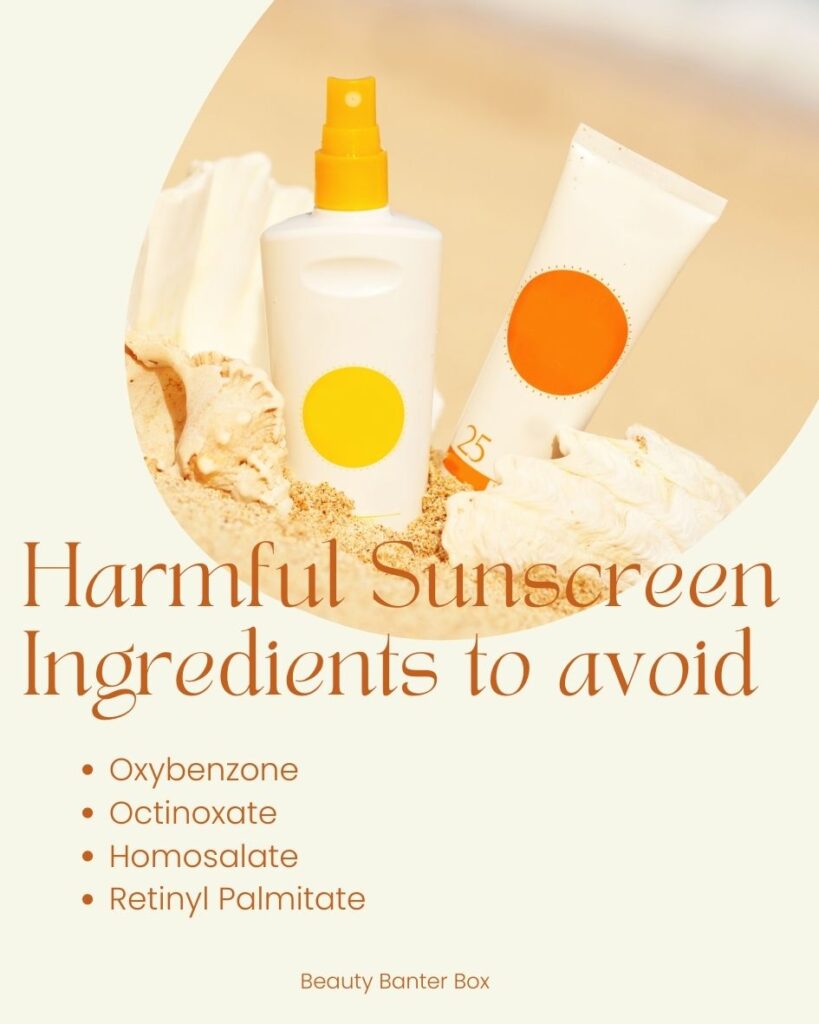
Octinoxate
Octinoxate! a notorious ingredient hiding in many sunscreen bottles. Octinoxate, also known as octyl methoxycinnamate, is a chemical compound commonly found in sunscreens and various personal care products. Octinoxate plays the role of a UV filter, absorbing and blocking UVB rays from the sun. It’s like the superhero of sunscreens, swooping in to protect our precious skin from sunburns. But beware, beneath that cape lies a potential supervillain.
Homosalate
Homosalate, also known as homomethyl salicylate, is a chemical compound commonly used as an active ingredient in sunscreens and other personal care products. It belongs to a class of chemicals called salicylates. Homosalate primarily functions as a UVB filter, helping to protect the skin from the harmful effects of the sun’s ultraviolet B (UVB) rays.
Retinyl Palmitate
Retinyl Palmitate, also known as vitamin A palmitate, is a synthetic form of vitamin A commonly used in skincare products, including sunscreens. It is a combination of retinol (a form of vitamin A) and palmitic acid (a saturated fatty acid). Retinyl palmitate is often added to cosmetic formulations due to its potential anti-aging and skin-enhancing properties.
Regardless of its safety, is worth noting that pregnant women may be advised to exercise caution when using products containing retinyl palmitate or other forms of vitamin A, as high doses of vitamin A have been associated with potential birth defects. Consulting with a healthcare professional or dermatologist is recommended for personalized advice.
Are you tired of spending a fortune on fancy skincare products that promise miracles but deliver disappointment? Say hello to your kitchen’s secret stash of beauty treasures!
Health Risks Associated with Oxybenzone, Octinoxate, Homosalate, and Retinyl Palmitate
Okay, now it’s time to address the elephant in the room. While oxybenzone may protect us from sunburns, it has some potential risks that might make you think twice before applying it to your skin.
Skin Irritation from Sunscreen
Imagine your skin throwing a tantrum right after you apply sunscreen. Itchy rashes, redness, and irritation are some common complaints linked to oxybenzone, which is trying to protect your skin only to end up irritating it!
Hormonal Havoc from Sunscreen
Brace yourselves for this one. Oxybenzone has been found to disrupt our delicate hormonal balance. It can mimic the hormone estrogen, leading to a hormonal rollercoaster. Ladies, if you’ve been searching for an excuse to blame your sunscreen for hormonal fluctuations, well, now you have one!
Allergic Reactions from Sunscreen
For some unfortunate souls, oxybenzone can trigger allergic reactions, ranging from mild to severe. Imagine going from a leisurely beach day to looking like a tomato, all thanks to your sunscreen choice!
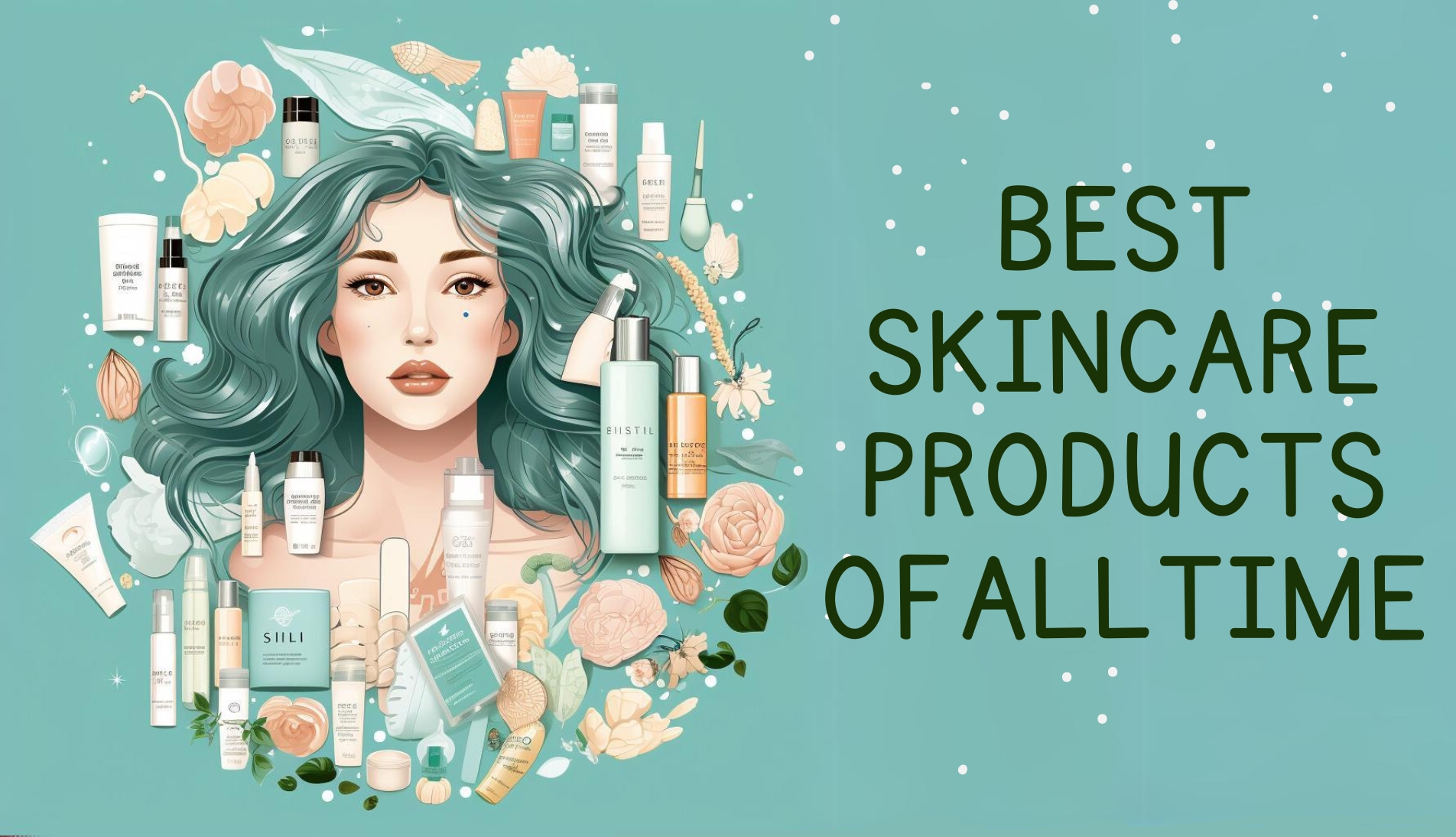






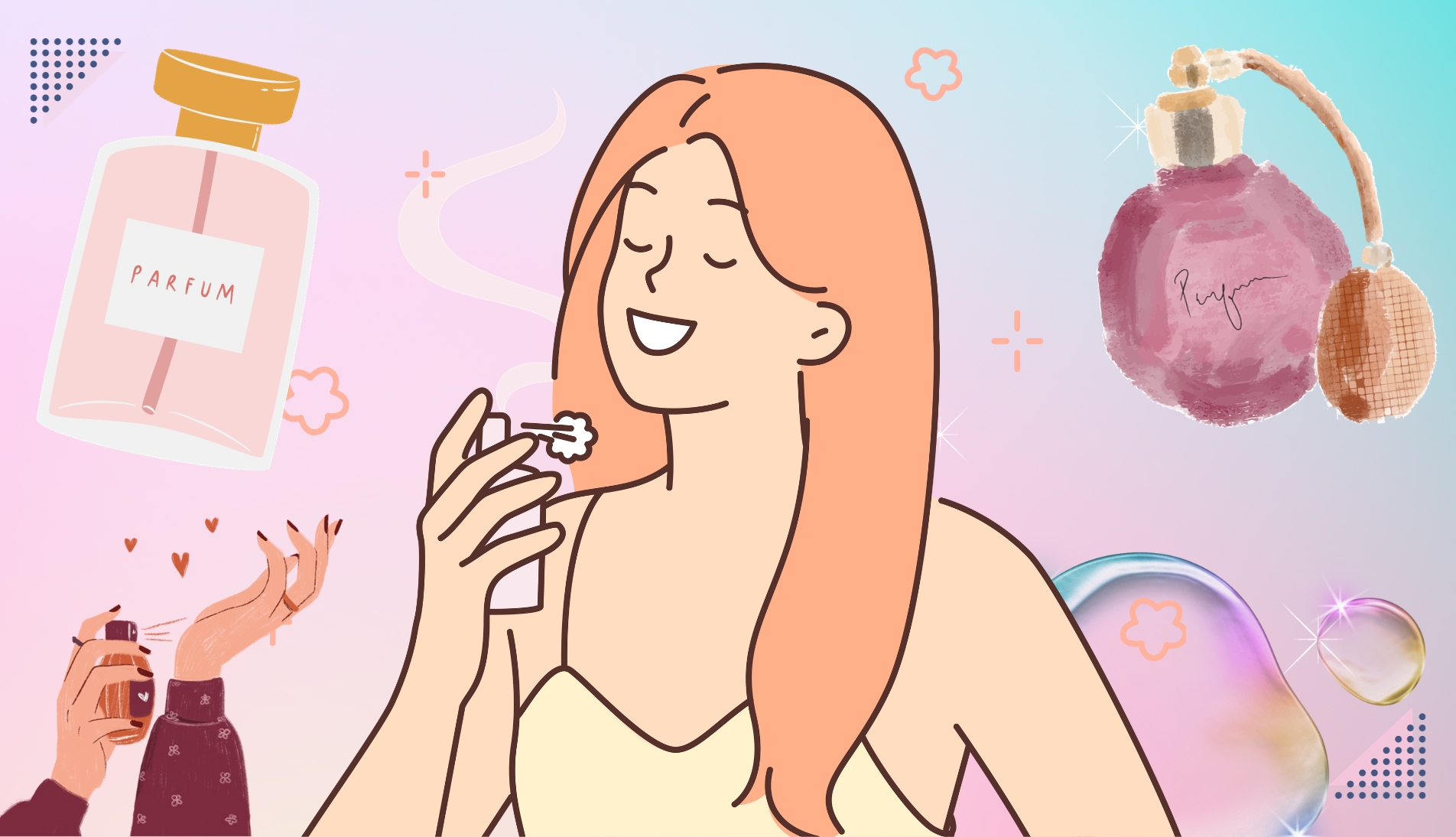

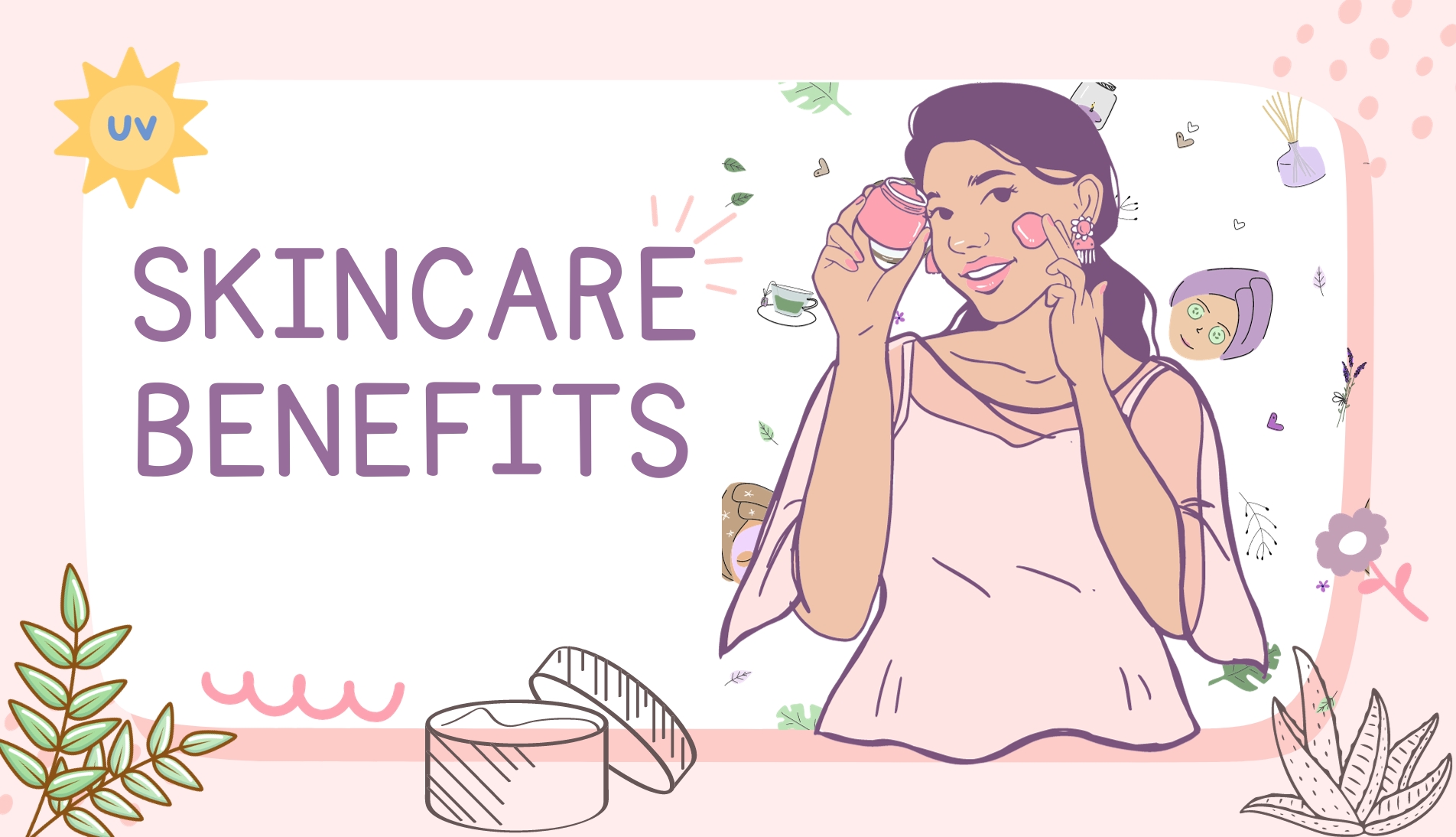
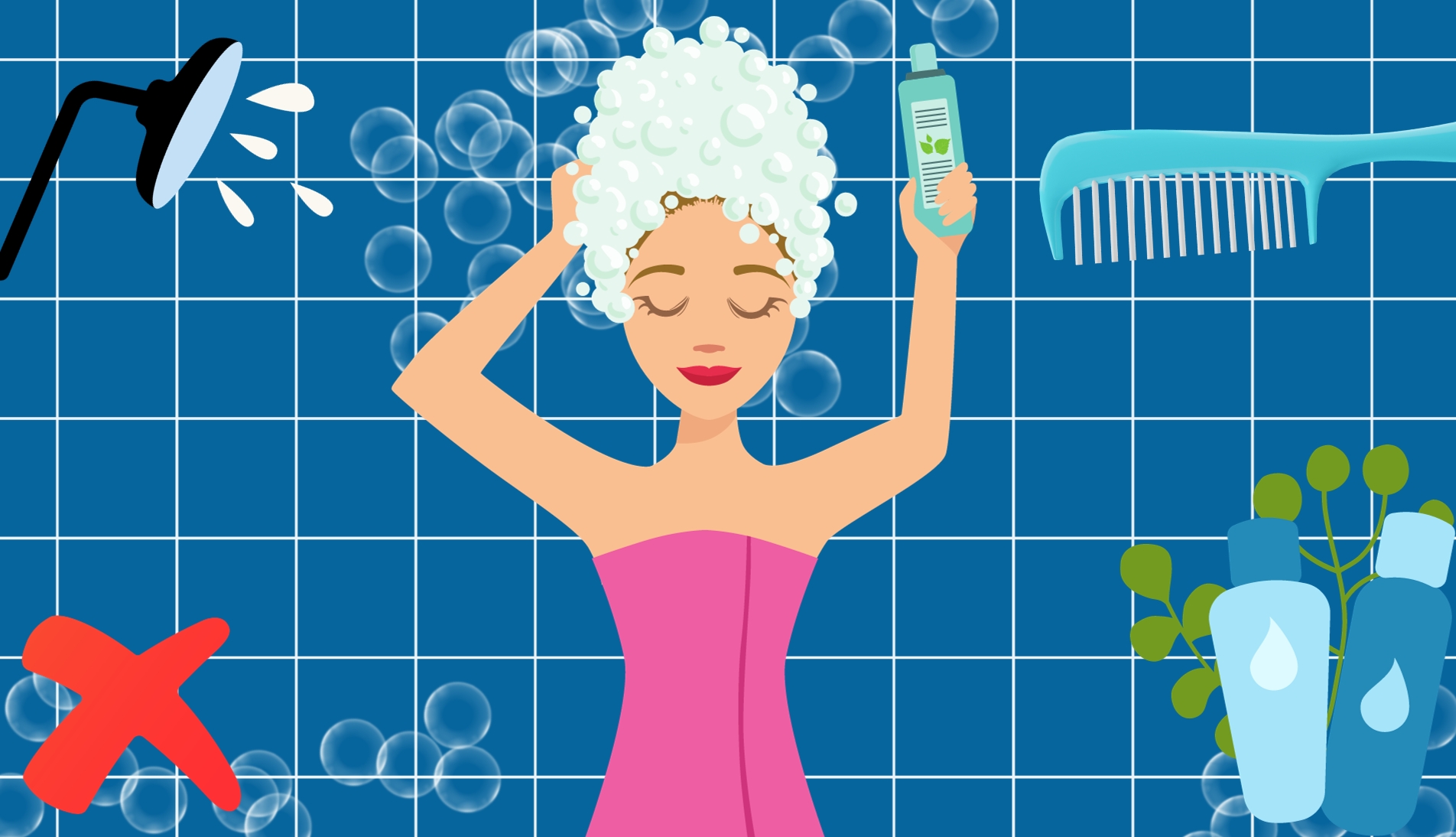

Environmental Impact of Oxybenzone, Octinoxate, Homosalate, and Retinyl Palmitate
Oxybenzone isn’t just a threat to our skin; it also poses risks to our oceans and marine life.
Coral Catastrophe
Oxybenzone has been found to be highly toxic to coral reefs. Even a minuscule amount of oxybenzone can cause coral bleaching and hinder their ability to reproduce. So, while we may be safeguarding our skin, we’re unintentionally harming these majestic underwater ecosystems.
Aquatic Anarchy
Oxybenzone doesn’t stop at corals, it wreaks havoc on other marine life too. Fish, turtles, and other aquatic creatures can suffer from deformities and DNA damage due to exposure to this chemical. It’s like oxybenzone has an evil plan to turn the seas into a mutant paradise!
Calling all dry-skinned beauties! It’s time to tap into the magic of K-beauty and transform your skin into a hydrated oasis.
Safer Alternatives to Avoided Sunscreen Ingredients
Zinc oxide in Sunscreen
Zinc oxide is a mineral compound that is commonly used as an active ingredient in sunscreens. It provides protection against the sun’s harmful ultraviolet (UV) rays. Zinc oxide acts as a physical sunscreen, meaning it creates a physical barrier on the skin that reflects and scatters both UVA and UVB rays.
When you apply sunscreen with zinc oxide, it forms a protective layer on your skin’s surface. This layer acts as a physical barrier, reflecting and scattering UV rays away from your skin. It’s like a mirror, bouncing those harmful rays right back into the abyss. Zinc oxide also has the remarkable ability to absorb and neutralize damaging free radicals, reducing the risk of cellular damage and premature aging. It’s like having a fortress that fights off the villains of aging while keeping your skin looking youthful and radiant.
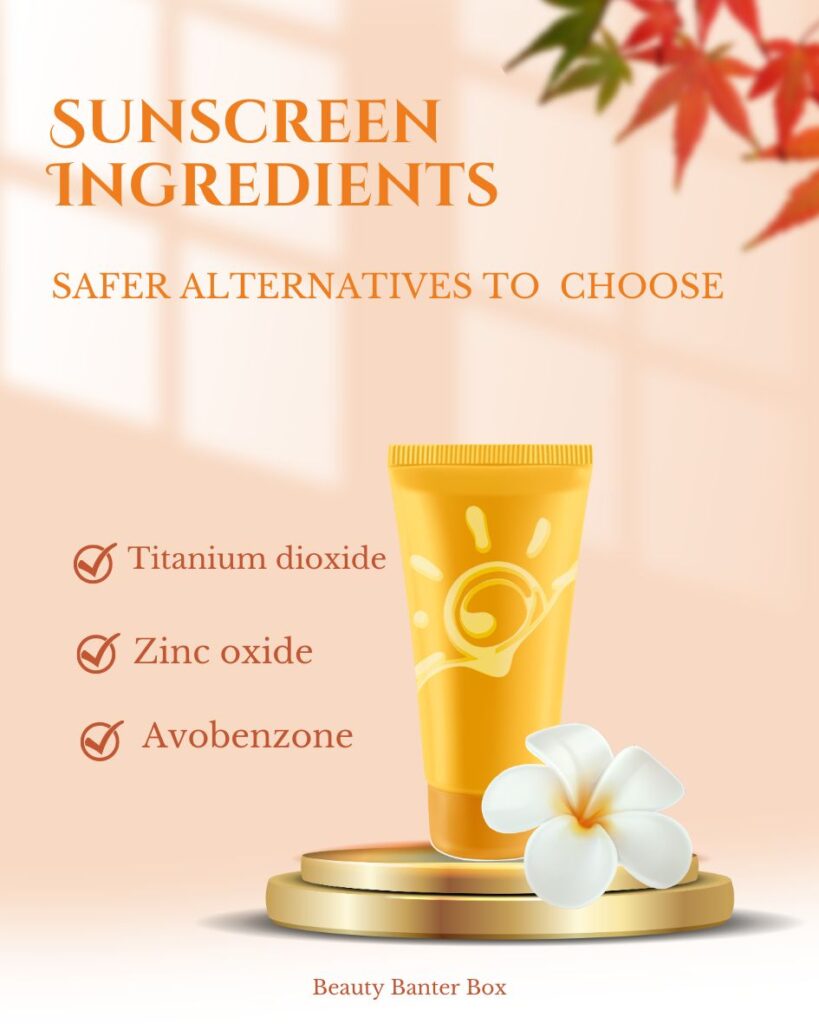
Titanium dioxide in Sunscreen
Titanium dioxide is a mineral compound widely used as an active ingredient in sunscreens. It provides protection against the sun’s harmful ultraviolet (UV) rays. Titanium dioxide acts as a physical sunscreen, meaning it creates a physical barrier on the skin that reflects and scatters both UVA and UVB rays.
In terms of cosmetic benefits, titanium dioxide is often used in sunscreens due to its ability to provide a cosmetically elegant finish. It can be finely milled into micro-sized particles, allowing for a smooth and lightweight application. Modern formulations have minimized the whitening effect that was associated with older formulations, offering more aesthetically pleasing options.
Avobenzone in Sunscreen
Avobenzone is a chemical compound commonly used as an active ingredient in sunscreens. It is part of a group of compounds known as benzophenones, which are effective at absorbing UVA (ultraviolet A) rays from the sun.
Avobenzone is generally considered safe for topical use, but it may cause skin sensitivity or allergies in some individuals. It is always recommended to perform a patch test or consult with a dermatologist if you have concerns about potential skin reactions.
Hey, beauty enthusiasts! Are you ready to dive into the world of K-beauty and achieve that enviable Korean glow?
Benefits of Safer Alternatives for Sunscreen
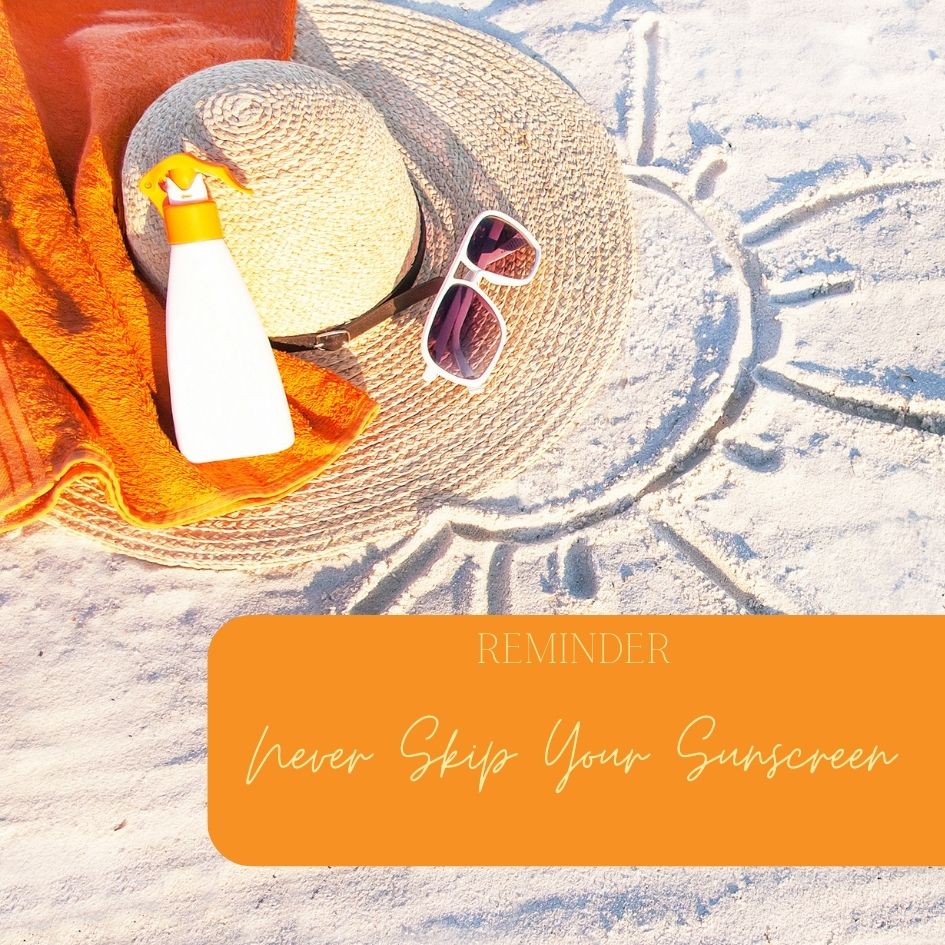
- Broad-Spectrum Protection: Zinc oxide offers excellent protection against both UVA and UVB rays. It acts as a physical barrier on the skin, reflecting and scattering the sun’s rays like a boss. With zinc oxide by your side, you can conquer any sunny adventure with confidence!
- Gentle on the Skin: Say goodbye to irritations and allergic reactions! Zinc oxide is known for its gentle nature, making it suitable for even the most sensitive skin types. It’s like having a superhero that saves the day without causing any collateral damage.
- Non-Comedogenic Awesomeness: Tired of dealing with clogged pores and breakouts? Well, zinc oxide has got your back! It’s non-comedogenic, meaning it won’t block your pores or contribute to pesky blemishes. Now you can rock that radiant, clear skin without worrying about unwanted surprises.
- Light as Air: Say goodbye to heavy, cakey sunscreens! Titanium dioxide has a magical quality that allows it to be lightweight and blend seamlessly into the skin. It’s like a feather-light veil of protection, leaving you feeling fresh and radiant.
Why Choose Safer Alternatives for Sunscreen
Sun Protection with a Dash of Confidence Ladies and gentlemen, it’s time to understand why zinc oxide is the go-to choice for sunscreens. Imagine a shield that not only protects your skin but also boosts your confidence to take on the world!
- Long-Lasting Protection: Zinc oxide forms a physical barrier on the skin that provides long-lasting sun protection. It doesn’t break down as easily as some chemical filters, giving you peace of mind during those extended outdoor adventures. Sunburn? Not on our watch!
- Immediate Sun Protection: Here’s the beauty of zinc oxide, no need to wait around for it to start working! As soon as you apply sunscreen with zinc oxide, it begins protecting your skin. No more impatiently waiting for the magic to happen. It’s like an instant shield against the sun’s rays!
- Safe for All Ages: Whether you’re a sun-loving adult, a playful kid, or a cautious parent, zinc oxide has got you covered. It’s safe for all ages, making it an excellent choice for the whole family. Say hello to worry-free beach days and outdoor fun!
Discover the Safest Alternatives for Your Skin
Wave Goodbye to Worries and Embrace Sun Care the Right Way
Tips for Choosing Safe and Effective Sunscreens
Look for Mineral-Based Sunscreen
Unleash the Power of Minerals Step into the realm of mineral-based sunscreens, where natural wonders await! These superheroes, like zinc oxide and titanium dioxide, form a protective shield on your skin, reflecting and scattering those harmful UV rays. It’s like having tiny magical mirrors on your skin—defending you from the sun’s mischievous tricks while keeping you radiant and safe.
Opt for Fragrance-Free Sunscreen Formulas
Ah, the sweet scent of summer! But when it comes to sunscreens, it’s best to skip the perfume parade. Opt for fragrance-free formulas to avoid potential skin irritations or unwanted clashes with your favorite scents. Let your natural beauty shine through without any added fragrant distractions. Plus, your nose will thank you for sparing it from an overload of scents!
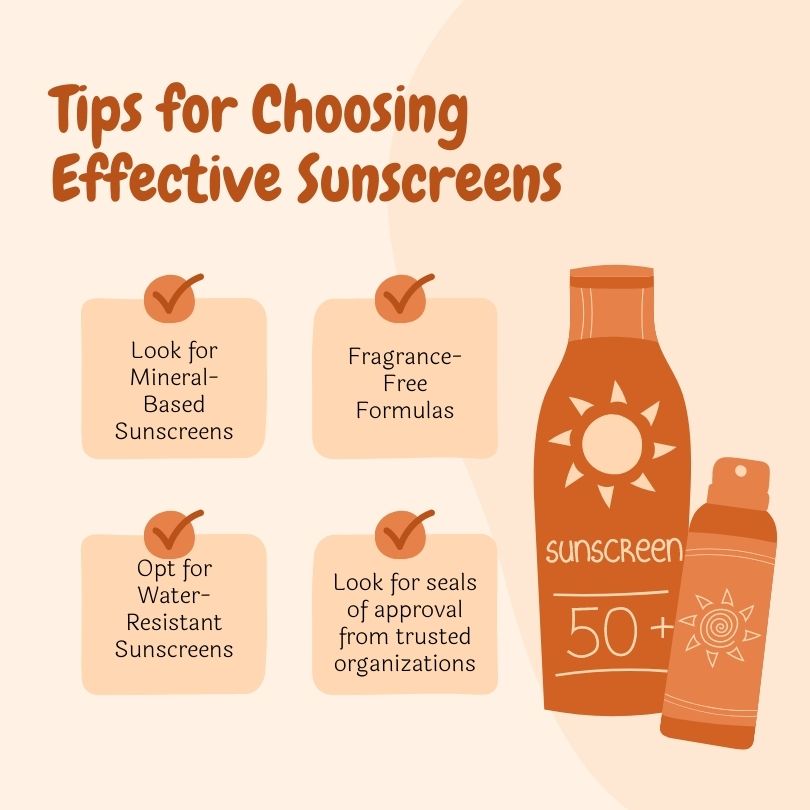
Consider Water-Resistant Sunscreens: Dive into Sun Safety
Splish, splash, we’re having a sun-safe bash! When choosing sunscreens, consider water-resistant options to keep your protection intact during your aquatic adventures. Whether you’re frolicking in the waves or sweating up a storm, water-resistant formulas cling to your skin, providing that extra layer of sun defense. Don’t let a dip in the pool wash away your sun protection dreams!
Check for Third-Party Certifications: Trust the Seal of Approval
Let’s bring in the reinforcements—third-party certifications! Look for seals of approval from trusted organizations like the Skin Cancer Foundation or the EWG (Environmental Working Group). These badges assure you that the sunscreen has met rigorous standards for safety and effectiveness. It’s like having a stamp of sun-smart approval from the experts, putting your mind at ease.
Conclusion
There you have it, fellow sun seekers! Armed with this sunscreen ingredient knowledge, you’re now equipped to make informed choices for your sun protection routine. Remember, avoiding certain sunscreen ingredients is like shielding yourself from the villains of skincare. Bid farewell to the sneaky oxybenzone, the drama queen retinyl palmitate, and the disruptor homosalate. Instead, embrace the sun-smart heroes like zinc oxide, titanium dioxide, and avobenzone. With these knowledge-packed superpowers in your sunscreen arsenal, you can frolic under the sun with confidence, knowing that your skin is well-protected

